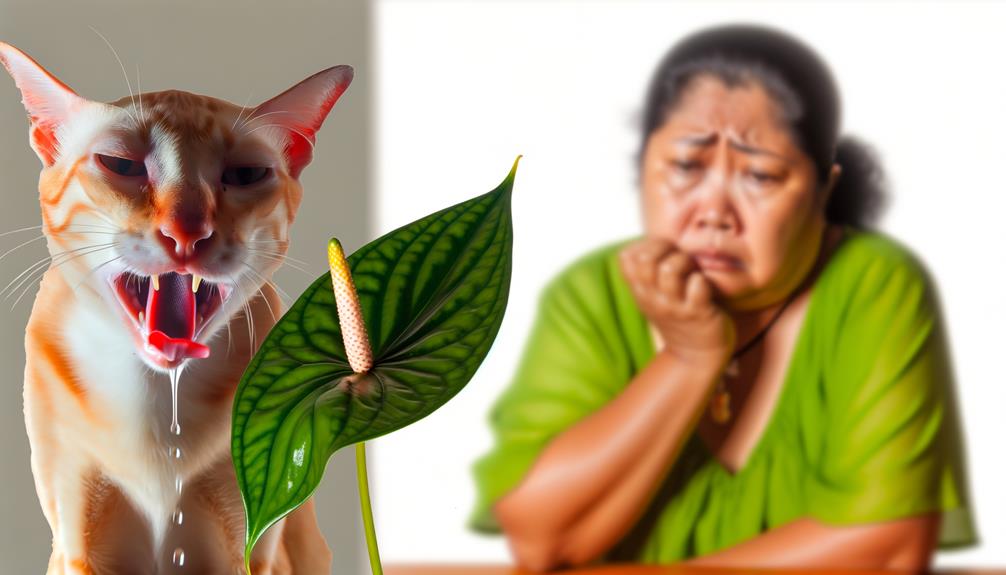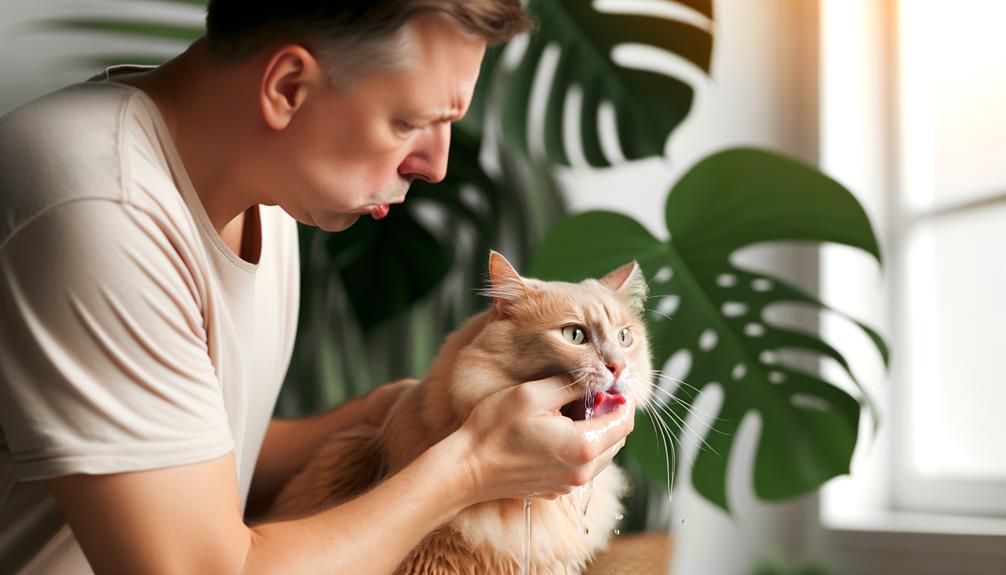7 Essential Steps for Treating Anthurium Poisoning in Cats
To treat anthurium poisoning in cats, start by identifying symptoms like drooling, oral irritation, and vomiting. Remove the plant immediately and isolate it.
Rinse your cat’s mouth gently with water to dilute toxins. Contact your veterinarian right away, providing a clear description of symptoms.
Offer fresh water to help flush out toxins and encourage hydration. Monitor for complications, particularly respiratory distress and gastrointestinal issues.
Follow your vet’s post-treatment care instructions, including dietary changes and scheduling follow-up checkups. By taking these steps, you’ll guarantee your cat’s safety and well-being.
Learn critical preventive measures and additional care tips to keep your feline friend safe from toxic plants.

Key Takeaways
- Remove the Anthurium plant from the cat’s environment to prevent further ingestion.
- Rinse the cat’s mouth with water to dilute and remove any remaining toxins.
- Contact your veterinarian immediately for professional advice and potential emergency care.
- Provide fresh water to help flush out toxins and encourage hydration.
- Monitor the cat closely for any signs of complications or recurring symptoms.
Step 01: Identify the Symptoms

When your cat ingests an anthurium plant, look for symptoms such as drooling, oral irritation, and difficulty swallowing. Anthurium toxicity can cause your cat significant discomfort and pose serious health risks.
You might also notice vomiting, pawing at the mouth, and decreased appetite. Immediate veterinary consultation is essential to confirm the diagnosis and discuss treatment options.
The veterinarian may recommend rinsing your cat’s mouth, administering medications to alleviate pain, or providing intravenous fluids. Prevention tips include keeping anthurium plants out of reach and educating all household members on its dangers.
Step 02: Remove the Plant
To prevent further exposure and reduce the risk of recurrence, promptly remove the anthurium plant from your cat’s environment. This immediate action guarantees no additional ingestion of toxic compounds.
Follow these steps:
- Isolate the Plant: Place it in a room or area inaccessible to your cat.
- Seek Veterinary Advice: Consult your veterinarian to discuss the incident and obtain professional guidance.
- Dispose of the Plant Safely: Assure it’s discarded in a manner that prevents any further access by pets.
- Consider Alternative Treatments: Explore non-toxic plant options to replace the anthurium, reducing future risks.
Step 03: Rinse Your Cat’s Mouth

Gently rinse your cat’s mouth with water to help remove any lingering plant residues and reduce the potential for further toxin absorption.
Begin by performing a thorough mouth examination, checking for visible plant material or irritation.
Use a syringe or a small cup to flush your cat’s mouth gently, taking care not to force water down their throat. This process helps to dilute any remaining toxins and can be vital in minimizing adverse effects.
After rinsing, carefully observe your cat for signs of distress, such as drooling or difficulty swallowing. If symptoms persist, it’s important to have your emergency contact information for your veterinarian readily available for immediate consultation.
Taking these steps can greatly impact your cat’s recovery.
Step 04: Call Your Veterinarian
Immediately get in touch with your veterinarian to discuss the symptoms and potential treatment options for your cat’s anthurium poisoning. It’s vital to act promptly, as these plants contain calcium oxalate crystals, which can cause severe oral irritation and gastrointestinal distress.
Your veterinarian will provide valuable veterinary advice to mitigate the potential dangers associated with anthurium toxicity.
Here are key steps to follow:
- Describe Symptoms: Clearly outline your cat’s symptoms, such as drooling, swelling, or vomiting.
- Follow Instructions: Adhere to the vet’s guidance for immediate care.
- Schedule a Visit: Arrange an emergency situation appointment if symptoms are severe.
- Learn Prevention Tips: Ask for tips to avoid future incidents.
Being proactive guarantees your cat’s swift recovery and safety.
Step 05: Provide Fresh Water

Ensuring your cat has access to fresh water is vital in helping to flush out the calcium oxalate crystals from their system and alleviate symptoms of anthurium poisoning. Proper hydration aids in diluting the toxins and can greatly reduce irritation in the mouth, throat, and digestive tract.
Encourage your cat to drink by placing multiple water bowls around your home. If your cat resists, consider adding water to their diet by mixing wet food with extra water. Maintaining their hydration is essential for prevention of further complications and supports the recovery process.
Always make sure that water is clean and changed frequently to promote consistent intake, which is crucial for speeding up the elimination of harmful substances.
Step 06: Monitor for Complications
Keep a close eye on your cat for any signs of complications, such as difficulty breathing, excessive drooling, or vomiting, which may indicate worsening of anthurium poisoning. Monitor closely for these symptoms and stay prepared to act swiftly. Watch for changes in your cat’s behavior and health, as early intervention can be critical.
- Respiratory Distress: Labored breathing or wheezing could signal severe complications.
- Gastrointestinal Issues: Continuous vomiting or diarrhea necessitates immediate veterinary attention.
- Excessive Drooling: Increased salivation can indicate oral irritation and distress.
- Lethargy: Unusual tiredness or weakness might suggest systemic effects of the toxin.
Seek professional help if any of these symptoms arise. Staying vigilant can make a significant difference in your cat’s recovery.
Step 07: Follow Post-Treatment Care

Consistently follow your veterinarian’s advice for post-treatment care to ensure your cat’s speedy and complete recovery from anthurium poisoning.
Make sure you schedule a follow-up checkup to monitor your cat’s progress and address any lingering symptoms.
Implement dietary changes as prescribed, which may include a gentle diet to alleviate gastrointestinal distress.
Observing behavior modification is vital; train your cat to avoid plants and identify safe environments.
Introduce plant alternatives that are non-toxic, like cat grass or spider plants, to satisfy their curiosity safely.
Diligently monitor for any signs of relapse or new symptoms.
Your adherence to these steps will greatly improve the recovery process and prevent future incidents of poisoning.
Conclusion
To sum up, treating anthurium poisoning in your cat calls for prompt and decisive action. By recognizing symptoms, eliminating the plant, rinsing your cat’s mouth, contacting your veterinarian, offering fresh water, monitoring for complications, and adhering to post-treatment care, you can greatly enhance your cat’s chances of a complete recovery.
Always seek advice from your veterinarian for personalized guidance. Keep in mind, timely intervention is key in reducing the toxic effects and safeguarding your cat’s health. Stay alert and proactive for your feline friend’s well-being.






